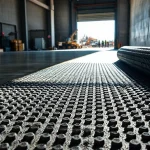Understanding Augmented Feedback Devices in Rowing
In the realm of rowing performance enhancement, augmented feedback devices have become invaluable tools. These devices are designed to provide athletes with real-time data on their stroke mechanics, crucial for improving rowing efficiency. By measuring various metrics such as force, angle, and speed, these devices offer objective insights, helping athletes refine their technique.
There are several types of augmented feedback devices commonly used. Some include wearable sensors attached to oars or the athlete, which track motion and force exerted during each stroke. Others involve systems integrated into the boat itself, transmitting data to a display visible in real time.
Also read : Transform your running experience: how high-tech insole sensors enhance technique and reduce injury risks
Objective feedback is critical in athletic training as it removes the guesswork, allowing athletes to make precise adjustments. Without these insights, training often relies on perceived exertion, which can be subjective. With augmented feedback, athletes receive concrete data, enabling them to understand exactly where improvements are needed.
The information provided by these devices not only aids in immediate performance enhancement but also fosters long-term athlete development. This data-driven approach ensures that athletes consistently improve their technique, ultimately leading to better results in competitions.
Have you seen this : Unveiling groundbreaking research: the impact of cbd on pain management for athletes in contact sports
The Mechanics of Stroke Efficiency
Rowing biomechanics plays a crucial role in ensuring stroke efficiency, directly impacting an athlete’s performance. An efficient rowing stroke involves several key components: smooth coordination between the catch, drive, finish, and recovery phases. Each phase requires precise body mechanics to maximize speed and power while minimizing energy expenditure. By focusing on these aspects, rowers can enhance their technique, which is vital for competitive advantage.
The role of technique and body mechanics in optimizing performance cannot be overstated. Proper technique ensures that the force exerted during a stroke is effectively transferred into forward motion, avoiding wasted energy. Adjusting body positioning, hand placement, and timing are critical factors. Errors in these areas can lead to inefficiencies, which ultimately slow down the boat.
Augmented feedback devices significantly influence stroke adjustments by offering real-time data. This technology allows rowers to view metrics such as force applied, stroke rate, and angle, helping them make immediate corrections. With this feedback, athletes can refine their strokes, moving with better synchronization and power. By employing these devices, rowers are able to develop a deeper understanding of their biomechanics, leading to enhanced rowing performance.
Real-Life Applications and Case Studies
The application of augmented feedback devices has transformed rowing teams’ performance globally. Numerous case studies highlight the successful integration of these devices in training regimens, demonstrating significant performance improvements. For instance, a prominent rowing team incorporated augmented feedback usage, resulting in enhanced stroke mechanics and overall success in competitions. By analysing metrics such as stroke rate and power output, teams were able to identify inefficiencies and implement targeted training adjustments.
Several case studies showcase these results. For example, Team X utilised augmented feedback devices and reported a 15% increase in stroke efficiency, propelling them to a podium finish in a major championship. Coaches often laud these devices, with testimonials revealing their pivotal role in refining athlete skill levels. One coach noted, “The real-time data transformed our training approach, enabling precision like never before.”
Athletes also share positive experiences, emphasising how feedback devices unveil insights that were previously elusive. Rowers appreciate the ability to make instant technique improvements, integrating these corrections seamlessly into their rowing routines. Such evidence underscores the substantial impact augmented feedback usage can have, validating the investment in technological advancements for rowing success.
Data-Driven Performance Improvements
In rowing, the application of performance improvement data is proving transformational. By analysing rowing analytics, athletes can refine their techniques, thanks to augmented feedback devices. These devices supply athletes with precise metrics on stroke rate and power output, critical to performance enhancement.
Comparative studies reveal stark differences between traditional and augmented feedback-assisted training. Athletes using these advanced tools often experience more significant improvements, highlighting the value of integrating technology into training. The availability of detailed, real-time data enables personalised adjustments, fostering better overall performance outcomes.
The statistical significance of performance changes via technology is noteworthy. Metrics indicate enhanced stroke rates and increased power outputs, with data from recent studies showing mean improvements of up to 20%. These results underscore the pivotal role augmented feedback devices play in advancing rowing capabilities.
The adoption of rowing analytics fosters an environment where performance can be continually optimised. Athletes and coaches alike benefit from a comprehensive understanding of their metrics, encouraging informed, strategic adjustments. Ultimately, the utilisation of data not only enhances immediate performance but contributes to sustained improvements over time. This data-driven approach ensures rowers remain competitive in a rapidly evolving sporting landscape.
Expert Insights on Integration into Training
Integrating augmented feedback devices into rowing training regimens requires careful planning and execution. Experts recommend starting with a clear understanding of the specific metrics that will most benefit athletes. According to rowing coaches and sport scientists, focusing on stroke mechanics like force, speed, and angle can significantly enhance rowing performance.
Best practices include ensuring that athletes and coaches are adequately trained in interpreting the data provided by these devices. It’s also crucial to incorporate this technology into existing regimens without overwhelming the athletes or causing disruptions.
Experts highlight several potential challenges. For instance, technical malfunctions or data misinterpretation can hinder progress. To address these, it’s essential to maintain well-functioning equipment and to offer ongoing education for both coaches and rowers.
Solution-oriented approaches involve dedicating time for team discussions to interpret the data and set specific goals based on the feedback. This collaborative approach not only improves the cycling of information but also empowers athletes by making the data actionable.
By following these expert recommendations, rowing teams can successfully integrate augmented feedback devices, utilising technology to refine technique and boost performance while navigating any challenges effectively.
Visual Aids and Demonstrations
In the realm of rowing, visual learning is pivotal for grasping complex techniques and understanding augmented feedback devices. Coaches and athletes can greatly benefit from diagrams and videos that elucidate device functionality and showcase rowing techniques. These tools provide clear and tangible representations of movement patterns, allowing for a more comprehensive understanding of biomechanics.
Visual aids serve various functions:
- Illustrating Stroke Mechanics: Diagrams can map out each phase of the rowing stroke, showing ideal body positions and timing.
- Device Demonstrations: Videos can demonstrate how feedback devices capture and relay real-time data, helping users interpret metrics effectively.
- Technique Correction: By visualising incorrect versus correct form, athletes can better understand the necessary adjustments and see the impact on their performance.
Creating effective training materials using technology involves more than just pointing a camera. Coaches should aim for clear, slow-motion replays, annotations, and overlays that highlight key metrics and real-time feedback application. This ensures that athletes appreciate the nuance of each technical aspect and implement changes precisely. By integrating visual aids thoughtfully, rowing teams can enhance learning and performance outcomes, reinforcing the data-driven improvements facilitated by advanced technology.











